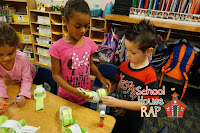It’s great to use for those moments when you
need students to complete a task independently with very little assistance from
you. It’s also a great activity to do
for morning work. It does use a lot of
copies but it’s worth it. Each scroll
sheet has a 10 by 10 table with boxes large enough to write numbers inside.
 |
| Scroll |
While the
number line helps with the concept of sequencing, and base-10 blocks reinforce
place value, the hundred chart combines these skills. This is one of the
biggest benefits from having the students complete the Scroll. Students see number lines, organized in groups
of 10. They also observe patterns of
tens and ones both horizontally and vertically.
Students
start out writing numbers 1-1,000. Writing the numbers 1-1,000 will have given us some time to learn different strategies to help with addition/subtraction. So then the scroll will transition to writing addition fact sentences up to 18. When they have reached that goal, they start
writing subtraction facts (starting at 18).
You can have students go up to any number you like. I do have ‘cheat sheets’ available for those
students who need extra support. I printed out charts 1-1,000 and laminated front to back on constuction paper. I keep them in a magazine holder next to the scroll sheets.
The
sides of the scroll sheet need to be cut so it fits on the paper towel roll
better. I tape the first sheet with
packing tape so it holds better but every sheet there after can be connected
with clear tape. I show my students how
to attach the sheet and how much tape they need for each.
I
write their names on the ends of the paper towel rolls.
I found a $3 basket at Goodwill to store them. It’s the perfect size for growing Scrolls.
Students
love to see how long their Scrolls can get.
I tell them it’s not necessary to unroll it every time they complete a
sheet but they enjoy looking at their progress.
Stay tuned to see the longest Scroll at the
end of the year!!

















